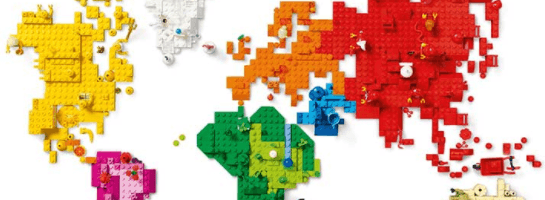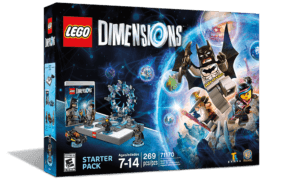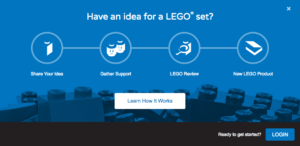LEGO in a Digital World

How the Danish toymaker is keeping pace in an era of digital transformation.
Shifts in digital technology are causing widespread disruptions across many industries, and the toy industry is in no way immune. LEGO Group, a Danish toy manufacturer, offers an example of both the challenges presented by digital technology in the world of physical products as well as the opportunities if digital trends are harnessed and effectively applied across a company’s business and operating models.
In in the late 1990s and early 2000s, LEGO had taken massive strides into the digital space, producing several generations of interactive websites, console games, and computer media. Yet by 2004 the company was in trouble, posting a $140M loss in March of the year and announcing that it would be cutting 500 Jobs.[1] In addition to production inefficiencies and supply chain problems, a significant contributor to this loss was the challenge posed by digital transformation, which had begun to take its toll on the company’s bottom line.
At the core of the problem was LEGO’s misapplication of digital transformation to both its business model and its operational model. In terms of the former, LEGO had diversified itself into digital mediums which distracted from its core product offering—the LEGO brick. Digital media and video games showed promise, but LEGO was simply not adept at developing them and saw a series of media flops with corresponding losses.[2] As for its operational model, LEGO’s Press Officer in 2004 described a general lack of information flow in the company: “We had a lot of knowledge silos within the organization. One hand was doing something that the other didn’t know.”[3]
Under a new CEO, Jorgen Vig Knudstorp, the company began to leverage digital technology to repair its past mis takes and return to its core value proposition. It did so by focusing on simultaneous improvements to its business and operational models.
takes and return to its core value proposition. It did so by focusing on simultaneous improvements to its business and operational models.
New Product Offerings: LEGO’s digital improvements to its business model refocused the company on its core physical product while allowing the company to still make inroads into other forms of entertainment. It made efforts to bridge the gap between digital media and physical LEGO bricks through more advanced software and hardware design. Its first game in this space, “Life of George,” was launched in 2011, and it allowed users to construct physical LEGO designs which then were scanned into the game.[4] “LEGO Dimensions,” launched in 2015, further developed this concept. The game employed about 300 physical LEGO pieces which were used to actually build the controller. The controller could then scan physical LEGO constructions and render them on the screen.[5]
Product Design: LEGO also leveraged digital technology to “crowdsource” its product design through communities of fans and designers on the internet. In 2008 it launched “LEGO Ideas,” a website in which users could create and submit product designs which were subsequently voted on by their peers. If the design received 10,000 or more votes, it would proceed to an official LEGO review board. Crowdsourced designs performed relatively well in the market, and the site also allowed the company to keep a thumb on current consumer trends and interests.[6]
New Enterprise System. Beginning in 2004 LEGO restructured its Enterprise IT system in order to improve data-sharing across the company. The complicated user interface was replaced with a simple, app-styled model which ensured each employee only operated apps applicable to his/her specific job. This decluttered the internal company site and allowed employees to quickly access required information. LEGO also adjusted its IT hiring policies and implemented a system of rotating its employees throughout the organization in order to build wider industry exposure. Furthermore, it instituted IT internship programs within its enterprise system and increased its hiring rate from Silicon Valley.[7]
LEGO’s use of digital technology since 2004 has been largely successful in improving its operating and business models, but there are additional areas of improvement that are worth considering as the company moves forward.[8]
Leverage Virtual Reality: Virtual Reality is becoming an increasingly important playing in the video game industry, and offers an opportunity for LEGO to continue to bridge its physical and digital worlds.[9]
Continue Licensing Model in Digital Media: This is an area in which LEGO has been incredibly successful, and the 2014 collected over $460 million at the box office. This model allows the company to continue its focus on its physical product while diversifying into alternative revenue sources.
Expand Design Crowdsourcing: LEGO should consider expanding the “LEGO Ideas” model to be more accessible to a broader array of designers. The current platform is quite stale and relatively difficult to use for a novice designer, which imposes a limit on the breadth of design ideas LEGO can access.[10] In addition, the company should consider national or global-level design competitions as part of a broader digital media strategy. (788 Words)
References:
- “Strategic Play – LEGO: Building up an empire.” New Media Age. 29 April, 2004. Accessed via ProQuest at http://search.proquest.com.ezp-prod1.hul.harvard.edu/abicomplete/docview/225140680/abstract/204948B098764946PQ/9?accountid=11311, 13 November 2016.
- Davis, Scott. “How LEGO Built up from Innovation Rubble.” 24 September, 2013. http://www.forbes.com/sites/scottdavis/2013/09/24/how-lego-built-up-from-innovation-rubble/#19a8602c9dcc, Accessed 13 November, 2016.
- Trangbaek, Roar Rude. “We Lost the Focus on the Bricks.” http://www.internationaltradenews.com/interviews/we_lost_the_focus_on_the_bricks/. Accessed 13 November, 2016.
- “LEGO Group Unveils First Fully Integrated Digital-to-Physical Gaming Experience.” PR Newswire. 29 September, 2011. Accessed via ProQuest at http://search.proquest.com.ezp-prod1.hul.harvard.edu/abicomplete/docview/896569043/9AD53CF2F066470EPQ/28?accountid=11311.
- Milne, Richard. “LEGO Builds New Dimension with Digital Vision.” Financial Times. 28 September 2015. Accessed via ProQuest at http://search.proquest.com.ezp-prod1.hul.harvard.edu/abicomplete/docview/1727763678/204948B098764946PQ/12?accountid=11311.
- Amsinck, Herrik et al. “Building the Foundations and Enterprise Capabilities for Digital Leadership: The LEGO Experience.” 21 August, 2015. http://dinst.dk/UserFiles/Artikler/LEGO_SIM_Digital_Leadership_Paper_-_SIM_WIN.pdf, Accessed 13 November 2016.
- Ibid.
- For an overview of the company’s growth over the past 12 years, see: Ringen, Jonathan. “How LEGO Became the Apple of Toys.” 1 August, 2015. https://www.fastcompany.com/3040223/when-it-clicks-it-clicks, Accessed 13 November 2015.
- LEGO has made some progress in this area with “Lego Fusion.” See also: http://www.theverge.com/2014/6/19/5821476/augmented-reality-lego-fusion-hands-on
- See: https://ideas.lego.com/
Image References:
- https://www.lego.com/en-us/aboutus/news-room/2015/february/lego-group-2014-annual-results, Accessed 16 November, 2016.
- https://www.lego.com/en-us/dimensions/how-to-play, Accessed 16 November, 2016.
- https://ideas.lego.com/, Accessed 16 November, 2016.
Additional Sources Consulted:
- “The LEGO Group History.” https://www.lego.com/en-us/aboutus/lego-group/the_lego_history/2000, Accessed 13 November 2016.
- “World Economic Forum White Paper, Digital Transformation of Industries.” Digital Enterprise. January 2016. http://reports.weforum.org/digital-transformation-of-industries/wp-content/blogs.dir/94/mp/files/pages/files/digital-enterprise-narrative-final-january-2016.pdf, Accessed 13 November 2016.




This is really interesting! I used to play with LEGO when I was a child, and I, of course, bought the most popular toy in the world for my son and daughter so that they can foster their creativity and they really love the bricks. I even visited LEGO LAND in Malaysia with my son and was impressed how people can be creative by stacking the same shape small pieces of bricks. Yet I really did not notice about the digitalization of the physical bricks which got a history of more than 80 years. Especially, “LEGO ideas” fascinates me. While it is similar to the product development of Threadless, as LEGO is universal and as both adults and children love it, it can be a broader community and reflect the taste of everybody. Indeed I could enjoy seeing it with my son. Though I think LEGO will be sustainably successful, it can attract more people if it could communicate its digital presence to the world more dynamically.
That’s too bad that kids are losing interest in LEGOs. This article caught my eye as a former avid-LEGO user. I think these new ideas are compelling – crowdsourcing designs, the LEGO movie, LEGO Dimensions, LEGO computer games – but they get away from the key value proposition of the toy – building a physical product with your hands. The more you steer away from this then the less relevant the brand is going to be. I think it would be better to integrate the physical LEGO blocks with digital space using sensors or something where the LEGOs can interact with the internet. Maybe you could build a LEGO object that then gets scanned in to be the spaceship for a computer game or something. That would put the tangible LEGO blocks front and center while still tying into digital media.
Hey Matt – Thanks for this post. I am a big personal LEGO fan and really enjoyed reading about the new initiatives. While I think the “Lego Dimensions” sounds like a great idea for the company, I worry about the broader implications for society. Doctors and scientists have demonstrated that too much time spent in front of a computer screen can have very detrimental effects on children, including developmental and neurological delays and a lack of interpersonal skills. Many articles have been written on the subject but here is a high-level overview: http://www.livestrong.com/article/85306-negative-effects-computers-children/. As one of the most iconic brands in physical play toys, it feels like Lego is moving down a slipper slope with its integration of gaming software into ints core brick product. If the major toy brands won’t stand firm and promote social play in young children as opposed to digital play, who will?
Thanks so much for the post, Matt!
Before I started reading, my first thought was that Lego has managed to stay pretty relevant in the digital and media world from my perspective, but the entirety of the success of their movies, games, etc. is dependent on invoking nostalgia and childhood memories formed by consumers while playing with actual Legos. Otherwise, their digital/media projects would require convincing customers that oddly-shaped characters and blocky worlds should be entertaining for some reason.
After reading your article, it’s comforting to know that Lego is doing a good job of improving their digital strategy while still focusing on building consumers’ love of their core products, instead of relying on self-perpetuation of their physical products’ popularity through nostalgic parents buying Legos for their kids. I think we’re all rooting for Lego to stick around for the long haul.
Have you seen the advertisement of the cartoon LEGO? It’s amazing. It also uses AR technology. Lego progressively develops in the field of AR from digital boxes in the store to advertising in public places. I think it’s cool for attracting new customers. Lego has an interesting history – https://invisible.toys/lego-history/ . Did you know how it appeared ?